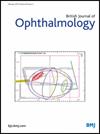高龄产妇生育会增加后代近视的风险。
IF 3.7
2区 医学
Q1 OPHTHALMOLOGY
引用次数: 0
摘要
目的探讨父母生育年龄与成年后代近视和高度近视风险的关系。方法本横断面研究纳入14044名英国生物银行参与者。近视和高度近视的定义分别为双眼平均球面度数(球面度数+1/2圆柱度数)≤-0.5屈光度(D)和≤-6.0 D。父母年龄分为<25岁、25-29岁、30-34岁和≥35岁。调整年龄、性别、种族、户外活动时间、Townsend指数、收入、教育程度、体重指数、吸烟和饮酒等因素后进行Logistic回归。在logistic回归模型中进一步加入父母年龄与户外活动之间的交互项。结果随着父母生育年龄的增加,成年子女近视和高度近视的患病率普遍增高。Logistic回归分析显示,高龄产妇近视和高度近视的风险显著增加。母亲年龄超过35岁与近视风险最高相关(OR, 1.42;p<0.001)和高度近视(OR, 1.56;p = 0.029)。然而,父亲年龄对近视和高度近视的风险没有显著影响。相互作用分析表明,与每天在户外活动0-2小时相比,超过2小时可以减弱母亲年龄对近视屈光不正进展的影响。结论产妇生育年龄的提高对后代近视和高度近视的风险有不利影响,可通过日常户外活动加以缓解。本文章由计算机程序翻译,如有差异,请以英文原文为准。
Advanced maternal reproductive age elevates myopia risk in offspring.
AIMS
To evaluate the associations of parental reproductive age with the risk of myopia and high myopia in adult offspring.
METHODS
This cross-sectional study included 14 044 UK Biobank participants. Myopia and high myopia were defined as a mean spherical equivalent (spherical power+1/2 cylindrical power) of both eyes ≤-0.5 dioptres (D), and ≤-6.0 D, respectively. Parental age was categorised as <25, 25-29, 30-34 and ≥35 years. Logistic regression was conducted after adjusting for age, sex, race, time spent outdoors, Townsend Index, income, education, body mass index, smoking and drinking. Interaction terms between parental age and outdoor activity were further added to the logistic regression models.
RESULTS
The prevalence of myopia and high myopia among adult offspring generally increased with parental reproductive age. Logistic regression analysis revealed that advanced maternal age significantly increased the risk of myopia and high myopia. Maternal age over 35 years was associated with the highest risk of myopia (OR, 1.42; p<0.001) and high myopia (OR, 1.56; p=0.029). However, no significant effect was observed for advanced paternal age on the risk of myopia and high myopia. Interaction analysis indicated that compared with spending 0-2 hours outdoors daily, more than 2 hours attenuated the effect of maternal age on progression of myopic refractive error.
CONCLUSION
Advanced maternal reproductive age had a detrimental effect on the risk of myopia and high myopia in offspring, which could be mitigated by engaging in daily outdoor activity.
求助全文
通过发布文献求助,成功后即可免费获取论文全文。
去求助
来源期刊
CiteScore
10.30
自引率
2.40%
发文量
213
审稿时长
3-6 weeks
期刊介绍:
The British Journal of Ophthalmology (BJO) is an international peer-reviewed journal for ophthalmologists and visual science specialists. BJO publishes clinical investigations, clinical observations, and clinically relevant laboratory investigations related to ophthalmology. It also provides major reviews and also publishes manuscripts covering regional issues in a global context.

 求助内容:
求助内容: 应助结果提醒方式:
应助结果提醒方式:


